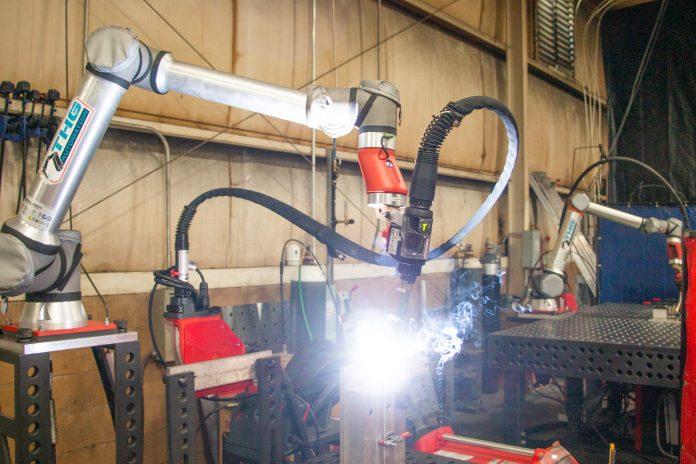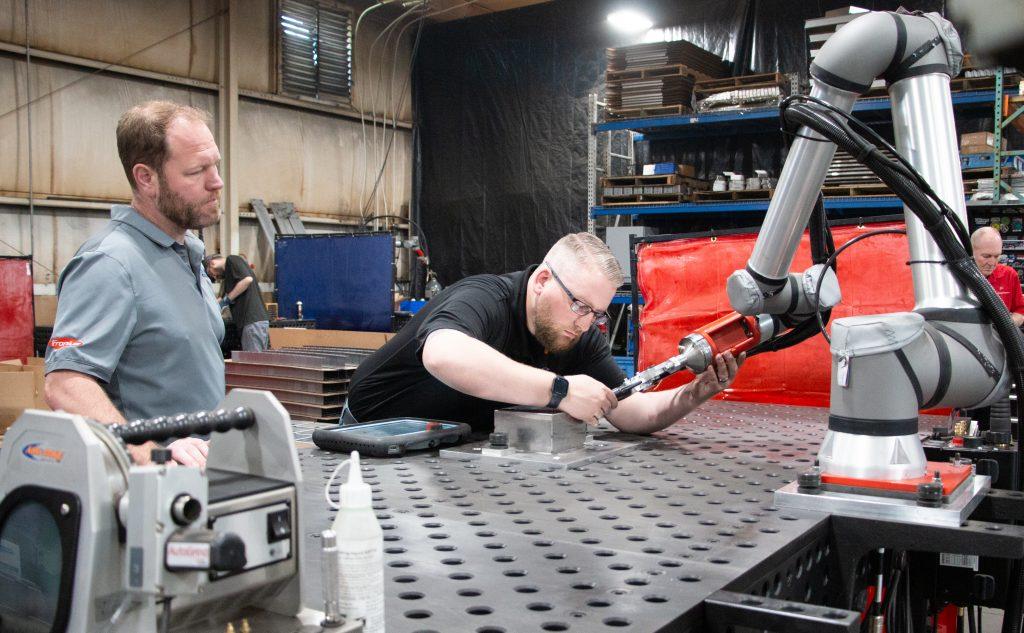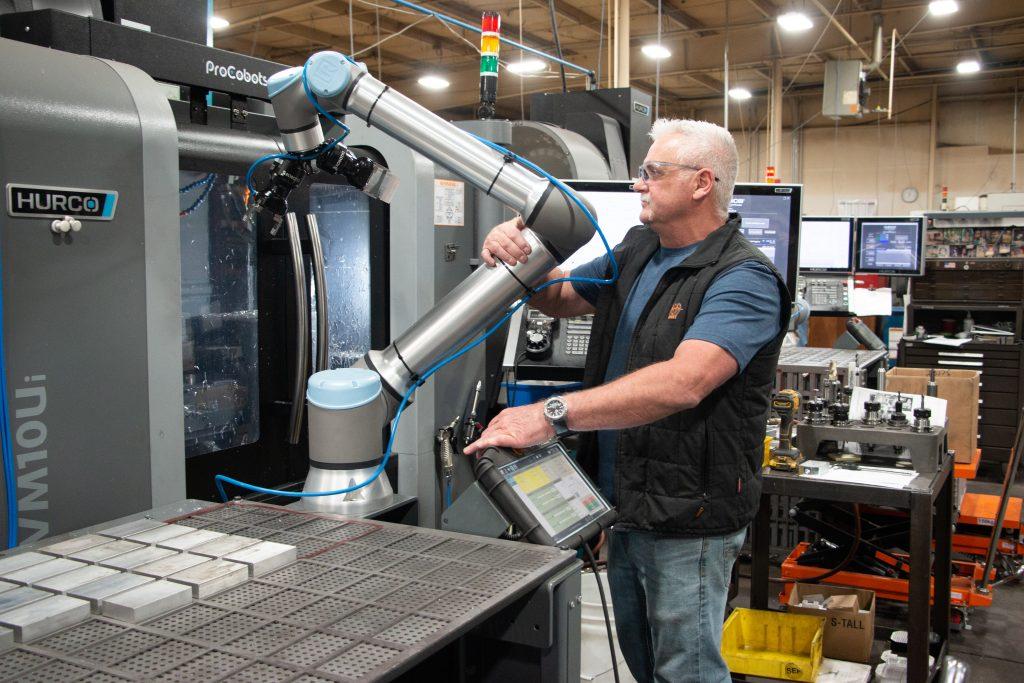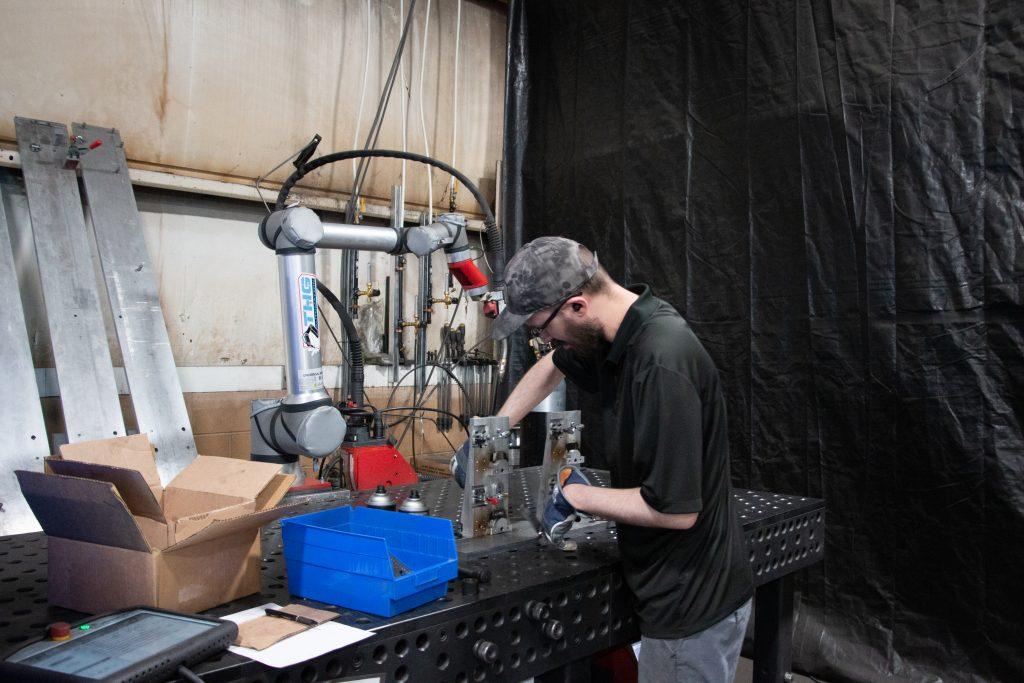
Ohio-based Raymath turns to user-friendly Universal Robots to automate complex TIG welding, as well as MIG welding and machine tending applications, driving revenue from $15M to $50M in three years.
“I’m always one who wants to try things myself—that’s what’s going to show me whether it’s going to work,” says Greg LeFevre, CEO and president of Ohio-based sheet metal fabricator Raymath. While researching automation options, LeFevre had discovered Universal Robots (UR), and when he found a UR certified systems integrator, THG Automation, close by, THG’s CEO Matt Hendey invited LeFevre to bring parts with him to get hands-on with the company’s UR cobot-based MIG welding system.
“Within the four hours that I was there, we programmed 20 weld points,” says LeFevre. “I was actually practicing and sampling on the parts that I was going to make. It proved to me without a doubt: if I can program this in four hours and actually have my parts running, there’s no doubt this can work in our shop. I wrote the purchase order that same night.”
Raymath started with a cobot-based MIG welding application and expanded its automation strategy to include complex TIG welding applications. The company has grown from $15M in revenue to $50M in about three years, and LeFevre attributes the growth to the fast adoption of technology. “The learning curve isn’t as steep as what people think it is. The cost to get into it isn’t as much as people think,” he states. “Don’t be afraid to take that step. You’re going to find out that even if it doesn’t go perfect, that ROI is going to be there in a pretty short time, and you’re going to find a new way and better ways, that will spur ideas from other people in the plant.”
Cobots bring automation advantages to high-mix, low-volume manufacturing
Raymath welds, presses, brakes, lasers, and machines metals of all sorts, for almost any industry. The company produces parts that go into conveyors for large warehouses, construction equipment used worldwide, transportation and parking automation systems, food equipment, and more. LeFevre and his business partner, Jay Woeste bought the 40-year-old tool-and-die shop in May 2019 and quickly expanded the company, despite the immediate challenges of the Covid-19 pandemic.
“Customers want to have fewer suppliers,” says LeFevre, “So instead of having a hundred suppliers, they would like to have ten that can do more. We wanted to satisfy those needs.” With a background in automation, LeFevre knew automation would be key to meeting their goals, but his experience was in high-volume, low-mix manufacturing. “It was very easy to automate when you make millions of a specific part. Moving into the fab-shop, sheet metal-type business, we’re now looking at a large number of different parts, but much smaller volumes of those parts.” Because traditional automation doesn’t lend itself to high-mix, low-volume, the company needed a much more flexible approach. “For us, robotics, and especially Universal Robots, has been who we turned to for a wide breadth of different parts with the same equipment,” he explains.
 Automated MIG welding yields 4X productivity improvement and “invaluable” customer relationship
Automated MIG welding yields 4X productivity improvement and “invaluable” customer relationship
Raymath, like most manufacturers, struggled to fill manufacturing and welding positions, especially during Covid. Raymath robotics specialist Nick Ogle says: “The THG robot units weld almost 50 percent faster than manual weld, sometimes more.” That lets Raymath produce parts more quickly with its existing staff, but also allows the company to support higher-volume orders.
With robotic welding, fixtures, push angles, speed, and heat are the same every time, which leads to faster, more consistent, and higher-quality welds than manual welding. Cobot arms can also reach all the way around a part in ways a human welder can’t, so almost all welds can be done without rotating the part. And with fewer starts and stops, robotic welding produces a cleaner weld that also reduces required grinding time.
As a high-mix shop, Raymath started with about twenty different parts on the THG welding system, but LeFevre quickly saw new opportunities to add more parts. He says, “Within two months, we decided to buy a second robot because we had filled the first one up, and the guys—Nick especially, who is our leader in that area—was picking up on the programming as fast as we could add parts. We had people now coming to us saying, ‘This would be a good part to put on the THG unit.’” Some of these requests came from operators who didn’t want to manually weld difficult parts; some came from the plant manager who saw the ability to fill larger orders; others came from supervisors who needed additional manpower to fill orders.
Gratifying to see all four cells run
At Raymath, two robot operators typically run two THG welding cells each, depending on workload and cycle times. “The operators will typically run one robot, hit start, and while that one’s running, they’ll be loading the other one, and then will just jump back and forth,” Ogle explains. “Seeing all four cells run at the same time is pretty gratifying, knowing you’re pushing that much product out the door that much faster.”
For one aluminum part, the UR-based THG welding system has reduced weld times from 15 minutes per part manually to five to six minutes per part; for another, weld times shrunk from three to four minutes each to 30 to 40 seconds.
Cobots handle hard-to-staff processes with half the number of operators, and weld at twice the speed, resulting in 4X productivity improvement. But LeFevre says, “Really, it’s the opportunity cost that I view as the most invaluable. There was business that we were able to take on that we would have never had the manpower and the ability to do.” Now that Raymath can satisfy all of customers’ needs, customers are less like to go to a competitor who might also gain future business. “It builds a better relationship with our customer, and how you measure that is hard to tell, but I know that it’s extremely valuable.”

Automated TIG welding system addresses both stainless and aluminum parts up to 6X faster than manual welding
Complex aluminum welding was one of Raymath’s biggest challenges for growth, as it was all TIG welded by hand with precise welds on top and underneath, with difficult angles and heat settings, and multiple moving parts. After seeing success in MIG welding, LeFevre approached THG for a TIG solution. “It was an extension of what we were doing with our MIG welding, so adding TIG to our package with the Universal Robot was pretty seamless,” says Hendey. “Once you get the precision and everything down, the THG unit can make a very, very good TIG weld, and can do it anywhere from two to six times faster than doing it by hand.”
Hendey notes that while automated MIG welding can be applied to many different materials and applications, it may be difficult for manufacturers to justify both a MIG system for aluminum parts and a TIG system for stainless parts, especially at low volumes. With the THG cold wire feed push/pull TIG system, Raymath can weld both stainless and aluminum parts with the same system. The UR cobots in the THG system can also work around fixtured parts in one process. Some parts are much larger than the table they’re being welded on, so those parts are fixtured so the TIG weld occurs on the table and the rest of the part hangs off the edge.
Easy programming for both TIG and MIG welding
LeFevre says, “I’m always looking at ease of use, and I found that the Universal Robot’s programming method was probably better than anyone’s out there. I really wanted to find a solution, knowing that we were going to change parts all the time, that had the programming and the implementation as easy as possible, and Universal Robots just fit the bill.”
THG’s Hendey adds, “With UR, unlike other robot brands, you get an open platform. There’s a lot of templates, there’s a lot of functionality that’s already built into the software, and the capabilities through the load-sensing that they offer and the intrinsic safety that allows it to be collaborative.” This open platform allowed THG to create a customized robotic welding system with their own software to address customer needs.
THG created URCaps (software handshakes between the UR cobot and peripherals) that made the welding system easy to use, even for operators without previous robotics experience. Ogle, a manual welder by trade, simply moved the robot arm where it needed to be for the weld, and at the correct angle, and used the teach pendant to save the point. “UR and THG is the first time I’ve ever used collaborative robots, and I was very surprised at the ease of use,” says Ogle.
This ease of use is a key element of the THG design. While THG provides one to three days of training for new systems, “A lot of times our customers will already have an application running in the welding before we even show up,” says Hendey. “When they call us down the road, it’s not about, ‘How do we make this thing still work?’ It’s about ‘Now I know how to do all this stuff, I want to get into the more advanced functionality of it.’”
 UR cobots manage CNC machine tending with Hurco and Easy Robotics ProFeeder
UR cobots manage CNC machine tending with Hurco and Easy Robotics ProFeeder
Beyond welding, Raymath also turned to UR for its machine tending automation needs, adding the UR cobot-based ProFeeder machining cells from ProCobots to its two 3- and 5-axis Hurco CNC machines. LeFevre says, “Using the ProCobots Hurco solution seemed like a very natural fit for us. We already had Hurco units, and we loved the conversational programming that goes on there.” Larry Dare, CNC machining supervisor at Raymath, had never worked with robots and according to LeFevre, quickly became efficient at making the system work well. LeFevre says, “Now, not only can Larry be sitting at his desk attending to his paperwork, he’ll have two Hurcos running right in the background for him, that he can attend to only when they need parts, setting them up so that they can run parts when he is gone.” That allows the second shift to simply monitor the automated systems while running other machines, and the systems are still running when the first shift arrives the next morning, without having someone on third shift attending to them.
“We get 24 hours of machining time where we’ve never been able to get that before,” LeFevre states. That lights-out processing gives Raymath more than a 600% productivity boost in machining, getting double the hours with the same number of workers. This is especially important when workers—especially for third shift work—are in short supply.
ProCobots provided training and has simplified the systems over time with software updates. Dare says, “I’ve managed CNC areas for probably 15 years now. But the robot portion of it—we don’t have a whole lot of people that have their hands in that. It’s really just me and one guy on second shift. With the training that we’ve had, we’re usually able to get in and troubleshoot any problems we might have, and work through them ourselves and do all the programming of any new parts.”
The programming itself is straightforward. “The robot has a general path that it follows to take the part into the machine,” Dare explains. “Really, all you’re teaching it is from that point to the vise and where to place the part in the vise.”
Future cobot uses, from grinding to press brakes
Raymath expects to continue its growth-through-automation strategy, likely beginning with grinding—a dirty, dusty job that is perfect for robotics—as well as press brake tending.
And if business needs change, UR cobots can be easily redeployed into other applications, from material handling to screw driving or any other manufacturing process. When customers ask how difficult that is, THG’s Hendey tells them, “Well, it’s a couple settings and re-bolting the equipment to the tables, and they can be off and running again within a day or so.”

Cobot-based systems deliver ROI and workforce advantages
In terms of ROI, LeFevre says, “Any time you’re investing in a new technology, you’re going in with the belief that it’s the right investment, that the ROI is going to be right. With these units, there’s no doubt that we’re getting about a one-year ROI at this point in time.” But while immediate ROI is easy to measure from a labor-saving standpoint, he emphasizes the ongoing return from additional opportunities and growth that technology has provided.
And as the company grows, LeFevre expects to continue to grow Raymath’s workforce who will be employed in more interesting, valuable jobs. “We are hoping to use the robots to attract talent,” he says. “We want to be known as a technology company that happens to do metal parts. Because then we can attract the talent to allow us to take us the next step.”
LeFevre is adamant about the role of robots and jobs. “People believe robots take away jobs. I will always say robots add jobs. The more you can do for your customer, the more jobs you’re going to end up having. For every robot that I’ve put in, I’ve probably added four people,” he says adding that he sees manufacturing as the basis for many countries’ economies. “And it’s going to take things like collaborative robots to allow not only the United States—but a lot of industrialized countries—to stay strong in manufacturing. UR has been the leader in collaborative, and they’re a good partner to try to make that happen.”




















